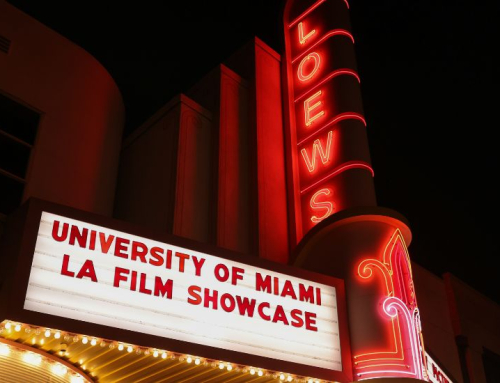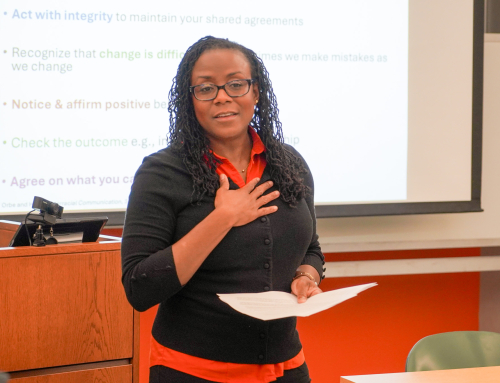A total of five faculty members spread across three departments were recently announced as the 2017 – 2018 recipients of the Creative Activity and Research Grants. The funding supports work that will result in clear and prominent scholarly and/or creative accomplishments that support the enhanced reputation of the School of Communication.
Wan-Hsiu “Sunny” Tsai, William Hughes, and Juliana Fernandes from the Department of Strategic Communication, Victoria Oreggo Dunleavy from the Department of Communication Studies, and Michelle Seelig from the Department of Cinema and Interactive Media were selected by an interdisciplinary committee of peers from the school.
Tsai, along with co-applicant Weiting Tao, also from the Department of Strategic Communication, will be focusing on China in her study, Local Brands and the Global Vision: The Pursuit of the Chinese Dream. A Chinese doctoral student in the SoC will conduct two focus groups in China to understand how consumers recognize brands both globally and locally.
“This study will explore Chinese consumers’ complicated relationships with local and global brands in relation to global and local culture positioning strategies, as well as the moderating role of consumer nationalism and belief in global citizenship,” explains Tsai.
The study will be conducted by matching the best-known global brands with their best-known local counterparts for comparison: Coca Cola and Feichange Cola for example.
Tsai plans to submit a manuscript based on the finding for publication in 2018.
Hughes’ project, “Creative Positive Visual Communication at Earlington Heights Elementary,” is an inaugural project of the ongoing cultural initiative “Bridge Walls,”which seeks to positively change the visual communication of Earlington Heights Elementary through art.
“Local, regional, and international artists are being recruited to create murals of different cultural perspectives, ideas, techniques, and worldviews, and will be installed on no fewer than 19 large communal walls of Earlington Heights,” says Hughes.
The project is expected to be completed January 2018.
With the research funds, Seelig plans to investigate the relationship between Millennials’ perceived online exposure to information about social causes and Millenials’ perceived barriers and willingness to take part in person in her project, Social Activism: Engaging Millenials in Social Causes.
“Although [Millenials] are actively involved in advocating social change through social media, national surveys of civic engagement indicate face-to-face participation drops off after high school and while attending college,” Seelig said.
She is surveying Millenials across the country asking if they are more engaged now compared to in high school, what hinders civic engagement (work, school, etc.), and if they are strictly participating online or actually taking part in person.
“That’s what this project is looking at. What do you need to be motivated to show up in person?” Seelig asked.
So far, Seelig is seeing that Millenials are more engaged online. However, she is optimistic about future civic engagement activity.
“I predict more [civic engagement] because I think we’re at a pivotal moment right now,” she said. “Young people are more socially aware and socially conscious of what is going on in this world.”
Fernandes’ project, Green Advertising Literacy: Using Copy and Creative Literacy Information to Combat Greenwashing, addresses the increasing skepticism among consumers about environmental benefits of advertised products. This major advertising setback, known as greenwashing, has reduced the demand for green products.
“Informing consumers about how to judge environmental messages will empower them and facilitate informed decision-making about green products,” Fernandes said.
The project includes a customer survey and a field experiment where participants will be exposed to real acceptable and deceptive product packages to determine where they are able to identify the deceptiveness.
“Our ultimate goal is to propose the development of an education app that consumers can use in real-time to check the extent of deception in ads and product packaging,” Fernandes said.
She will be working with Dr. Sigal Segev from Florida International University and UM Ph.D. student Joy K. Leopold.
Victoria Orrego Dunleavy is traveling to Guatemala for her project titled, Empowering Local Comadronas in Indigenous Guatemala: A Tool for Sexual and Reproductive Health. She will be conducting focus groups of comadronas (midwives) across four health centers in the Lake Atitlan region to address the poor maternal health status by integrating an evidence-based HIV intervention, or SEPA (Salud, Educación, Prevención, and Autocuidado).
“SEPA is guided by a conceptual model that integrates Social-Cognitive Learning Theory, contextual tailoring and the World Health Organization primary health care model,” Orrego said.
She is using the slogan Mi Cuerpo, Mi Responsibilidad: Atitlan Contra VIH/SIDA, or My Body, My Responsibility: Atitlan Against HIV/AIDS, which emphasizes the message of community empowerment through learning about HIV prevention.
Orrego hopes to “promote the direction and development of a larger scale study that will lead to the cultural adaptation, pilot testing, implementation and evaluation of SEPA as a prototype intervention for indigenous Guatemala.”







